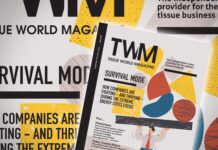Indonesia is a fascinating market offering huge potential for the tissue industry. Almost 251 million people and counting, geographically located as the gateway between Asia and Australasia and consisting of the largest archipelago nation in the world with some 17,000 islands – they think.
The economy continues to speed along, growing 6.2% last year and during the global recession it outperformed its regional neighbours joining China and India as the only G20 members posting growth in 2009.
As for tissue, Indonesia is now challenging South Korea in terms of volume growth. This is no mean feat, as last year’s country report published in August/September shows. No wonder one industry figure told me he sees the nation potentially forming another category to match the much vaunted BRIC economies … this one would be ICI, standing for India-China-Indonesia.
When I visited Indonesia at the end of March, this economic activity was evident everywhere. Traffic in the cities is in constant flow as a growing middle class experiences rapid economic growth, more job prospects as well as an increasingly westernised consumption culture. And that’s the key to that potential being realised for tissue.
Another top industry figure told me: “Things are changing, we are seeing more westernised habits for tissue use, but it does take time.” The Indonesian market was unique, he said. “Many people in local shops or homes will place a toilet roll on the table and use it as kitchen roll or facial roll… It’s very much a cultural thing.”
While nowhere in the world is the Blackberry more popular, the use of tissue in everyday life still has a lot of room for development. Tissue consumption lags behind similar sized economies largely because of a narrow acceptance of such products. Facial towels and toilet paper are the main selling products but the country’s cultural habits and access to spending power is still dictating the pace of toilet paper use.
For all its speedy economic growth, Indonesia is a developing nation that at the moment is largely held back by poverty and a complex regulatory environment. There has been a decade of painful restructuring, and only in the past few years have companies started to invest again. New tissue capacity is coming from a combination of smaller mills with modest machines to very large complexes with several mid to large-sized machines. APP and Sopanusa, which I visited for this issue, are a case in point. Sopanusa is a small company with eyes set on further global expansion in the export market with substantial plans to create a new company and invest in three new tissue machines that will eventually double its capacity.
The global paper giant is APP, a company well known for its aggressive expansion strategy as well as its troubled history with allegations of natural forest deforestation. But has there been a turning point? On 5 February it committed to “an immediate halt” in the clearing of natural forest across its entire supply chain in Indonesia with immediate effect.
This bold statement has been widely embraced, not only by the global pulp and paper industries but also by the media and the NGO’s that had targeted the company’s alleged illegal logging. APP has said its progress will now be independently verified by The Forest Trust.
Regardless, it has now positioned itself as a pioneer of sustainability and will need to be fully transparent. With the world’s eyes on the business, there is no going back.
However, further down TW’s APP story is a more telling long-term move. In Indonesia, APP’s strategic focus towards tissue becomes ever clearer as it looks to flex its muscle among the corporate giants of global growth.
Tissue World Magazine is part of the Informa Markets Division of Informa PLC
Tissue World Magazine is operated by a business or businesses owned by Informa PLC and all copyright resides with them. Informa PLC's registered office is 5 Howick Place, London SW1P 1WG. Registered in England and Wales. Number 8860726.

































